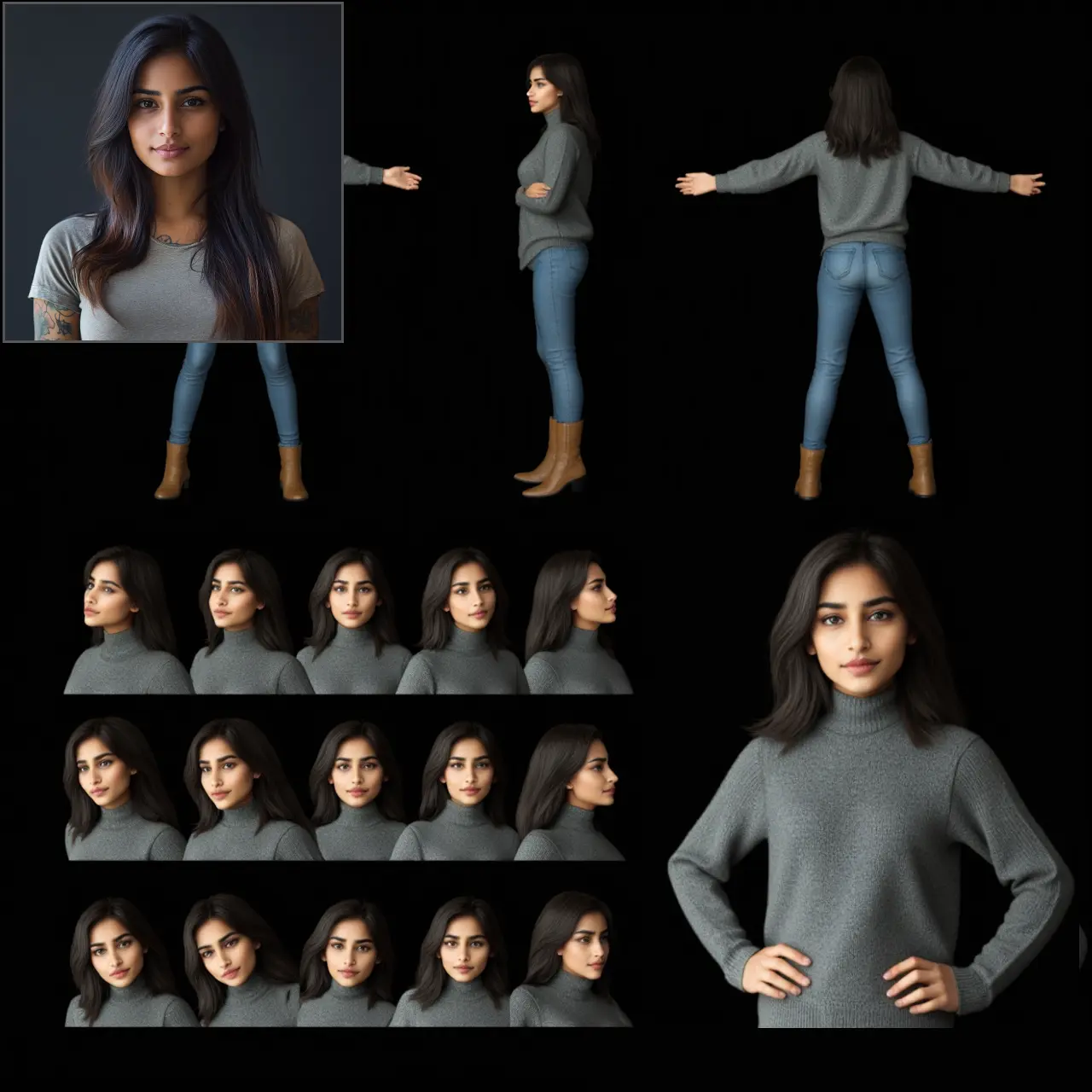ComfyUI Node: pipeKSamplerSDXL v1 (Legacy)
ttN pipeKSamplerSDXL
Category🌏 tinyterra/legacy
TinyTerra (Account age: 905days) Extension
ComfyUI_tinyterraNodes Latest Updated
2025-03-14 Github Stars
0.49K
How to Install ComfyUI_tinyterraNodes
Install this extension via the ComfyUI Manager by searching for ComfyUI_tinyterraNodes- 1. Click the Manager button in the main menu
- 2. Select Custom Nodes Manager button
- 3. Enter ComfyUI_tinyterraNodes in the search bar
Visit ComfyUI Online for ready-to-use ComfyUI environment
- Free trial available
- 16GB VRAM to 80GB VRAM GPU machines
- 400+ preloaded models/nodes
- Freedom to upload custom models/nodes
- 200+ ready-to-run workflows
- 100% private workspace with up to 200GB storage
- Dedicated Support
pipeKSamplerSDXL v1 (Legacy) Description
Advanced image sampling and processing node for AI artists within ComfyUI framework, leveraging KSampler algorithm for high-quality image generation and refinement.
pipeKSamplerSDXL v1 (Legacy):
The ttN pipeKSamplerSDXL node is designed to facilitate advanced image sampling and processing within the ComfyUI framework. This node leverages the KSampler algorithm to generate high-quality images based on various input parameters, including model configurations, noise settings, and sampling steps. It is particularly useful for AI artists looking to create detailed and refined images by controlling the sampling process meticulously. The node supports features like LoRA (Low-Rank Adaptation) for model fine-tuning, noise addition or suppression, and image upscaling, making it a versatile tool for generating and refining AI-generated artwork.
pipeKSamplerSDXL v1 (Legacy) Input Parameters:
pipe
This parameter represents the initial pipeline configuration, including the model, embeddings, VAE, and other components required for the sampling process. It is essential for setting up the initial state of the sampling pipeline.
lora_name
Specifies the name of the LoRA model to be used. LoRA models help in fine-tuning the main model by providing additional layers of adaptation. This parameter is optional and can be set to None if not used.
lora_strength
Determines the strength of the LoRA model's influence on the main model. Higher values result in more significant changes, while lower values make subtle adjustments. Typical values range from 0.0 to 1.0.
add_noise
Controls whether noise should be added to the sampling process. Options include enable and disable. Adding noise can help in generating more diverse outputs.
steps
Defines the number of sampling steps to be performed. More steps generally lead to higher quality images but increase computation time. Typical values range from 10 to 1000.
cfg
The classifier-free guidance scale, which influences the trade-off between image fidelity and diversity. Higher values prioritize fidelity, while lower values enhance diversity. Typical values range from 1.0 to 20.0.
sampler_name
Specifies the name of the sampler algorithm to be used. Different samplers can produce varying results, so experimenting with this parameter can yield different artistic styles.
scheduler
Determines the scheduling strategy for the sampling steps. This can affect the convergence and quality of the generated images.
image_output
Controls the visibility and saving of the output images. Options include Show, Hide, and Hide/Save. This parameter helps manage the output display and storage.
save_prefix
A prefix to be added to the filenames of saved images. This helps in organizing and identifying the generated images.
file_type
Specifies the file format for saving the images, such as png or jpg. This parameter ensures compatibility with different use cases and platforms.
embed_workflow
Determines whether the workflow metadata should be embedded in the output images. This can be useful for tracking and reproducing the sampling process.
noise
Defines the noise level to be added to the sampling process. This parameter can be used to control the randomness and variability of the generated images.
noise_seed
An optional seed value for the noise generator. Using a fixed seed can help in reproducing the same results across different runs.
optional_model
An optional parameter to specify an alternative model for the sampling process. This allows for flexibility in choosing different models for different tasks.
optional_positive
Optional positive embeddings to guide the sampling process. These embeddings can help in steering the generated images towards desired characteristics.
optional_negative
Optional negative embeddings to guide the sampling process. These embeddings can help in steering the generated images away from undesired characteristics.
optional_latent
An optional latent space representation to be used as the starting point for the sampling process. This can help in refining and continuing previous work.
optional_vae
An optional VAE (Variational Autoencoder) model to be used in the sampling process. VAEs can help in generating more coherent and high-quality images.
optional_clip
An optional CLIP model to be used for text-to-image generation. This parameter allows for integrating text prompts into the sampling process.
input_image_override
An optional parameter to override the input image used in the sampling process. This can be useful for refining or modifying existing images.
adv_xyPlot
An optional parameter for advanced XY plotting, which can help in visualizing and analyzing the sampling process.
upscale_method
Specifies the method to be used for upscaling the generated images. Options include various algorithms like nearest, bilinear, and bicubic.
upscale_model_name
The name of the model to be used for upscaling. This allows for integrating specialized upscaling models to enhance image quality.
factor
The upscaling factor, which determines how much the image should be enlarged. Typical values range from 1.0 to 4.0.
rescale
A parameter to control the rescaling of the image. This can help in adjusting the image dimensions to fit specific requirements.
percent
Specifies the percentage by which the image should be scaled. This parameter provides fine-grained control over the image size.
width
The desired width of the output image. This parameter helps in setting the exact dimensions of the generated images.
height
The desired height of the output image. This parameter helps in setting the exact dimensions of the generated images.
longer_side
Specifies the length of the longer side of the output image. This parameter helps in maintaining the aspect ratio while resizing.
crop
Controls whether the image should be cropped to fit the desired dimensions. This can help in focusing on specific parts of the image.
prompt
A text prompt to guide the image generation process. This parameter allows for integrating textual descriptions into the sampling process.
extra_pnginfo
Additional metadata to be embedded in the output PNG images. This can be useful for tracking and reproducing the sampling process.
my_unique_id
A unique identifier for the sampling process. This helps in managing and tracking different sampling runs.
start_at_step
Specifies the step at which the sampling process should start. This can be useful for resuming interrupted processes.
end_at_step
Specifies the step at which the sampling process should end. This can help in controlling the duration and quality of the sampling process.
return_with_leftover_noise
Controls whether the output should include leftover noise. Options include enable and disable. This parameter can help in generating more diverse outputs.
pipeKSamplerSDXL v1 (Legacy) Output Parameters:
ui
Contains the user interface elements, including the generated images. This parameter helps in displaying the results within the ComfyUI framework.
result
The final output of the sampling process, including the generated images and any additional metadata. This parameter provides the main results of the node's execution.
pipeKSamplerSDXL v1 (Legacy) Usage Tips:
- Experiment with different
sampler_nameandschedulercombinations to achieve various artistic styles and effects. - Use the
lora_nameandlora_strengthparameters to fine-tune the model for specific tasks or styles. - Adjust the
stepsandcfgparameters to balance between image quality and computation time. - Utilize the
upscale_methodandupscale_model_nameparameters to enhance the resolution and quality of the generated images. - Leverage the
promptparameter to guide the image generation process with textual descriptions.
pipeKSamplerSDXL v1 (Legacy) Common Errors and Solutions:
"Invalid pipe configuration"
- Explanation: This error occurs when the initial pipeline configuration is incorrect or incomplete.
- Solution: Ensure that all required components, such as the model, embeddings, VAE, and CLIP, are correctly specified in the
pipeparameter.
"LoRA model not found"
- Explanation: This error occurs when the specified LoRA model name is not available.
- Solution: Verify that the
lora_nameparameter is correct and that the LoRA model is properly installed and accessible.
"Sampling steps out of range"
- Explanation: This error occurs when the number of sampling steps is outside the acceptable range.
- Solution: Adjust the
stepsparameter to a value within the typical range of 10 to 1000.
"Invalid noise seed"
- Explanation: This error occurs when the noise seed value is invalid or not properly specified.
- Solution: Ensure that the
noise_seedparameter is a valid integer or leave it asNonefor random seed generation.
"Upscale method not supported"
- Explanation: This error occurs when the specified upscaling method is not supported.
- Solution: Choose a valid
upscale_methodfrom the available options, such asnearest,bilinear, orbicubic.
pipeKSamplerSDXL v1 (Legacy) Related Nodes
RunComfy is the premier ComfyUI platform, offering ComfyUI online environment and services, along with ComfyUI workflows featuring stunning visuals. RunComfy also provides AI Playground, enabling artists to harness the latest AI tools to create incredible art.


